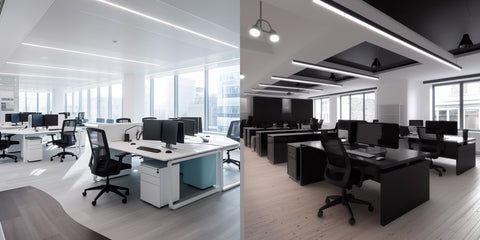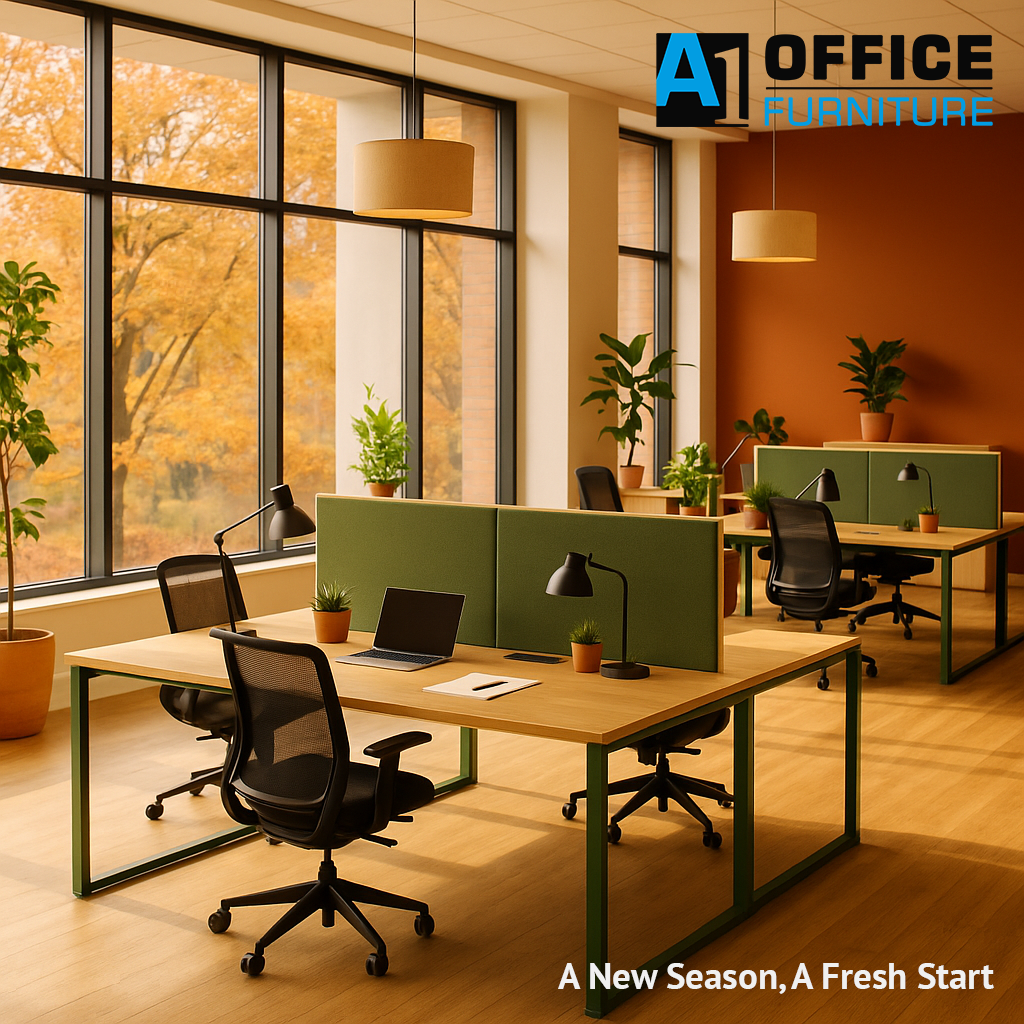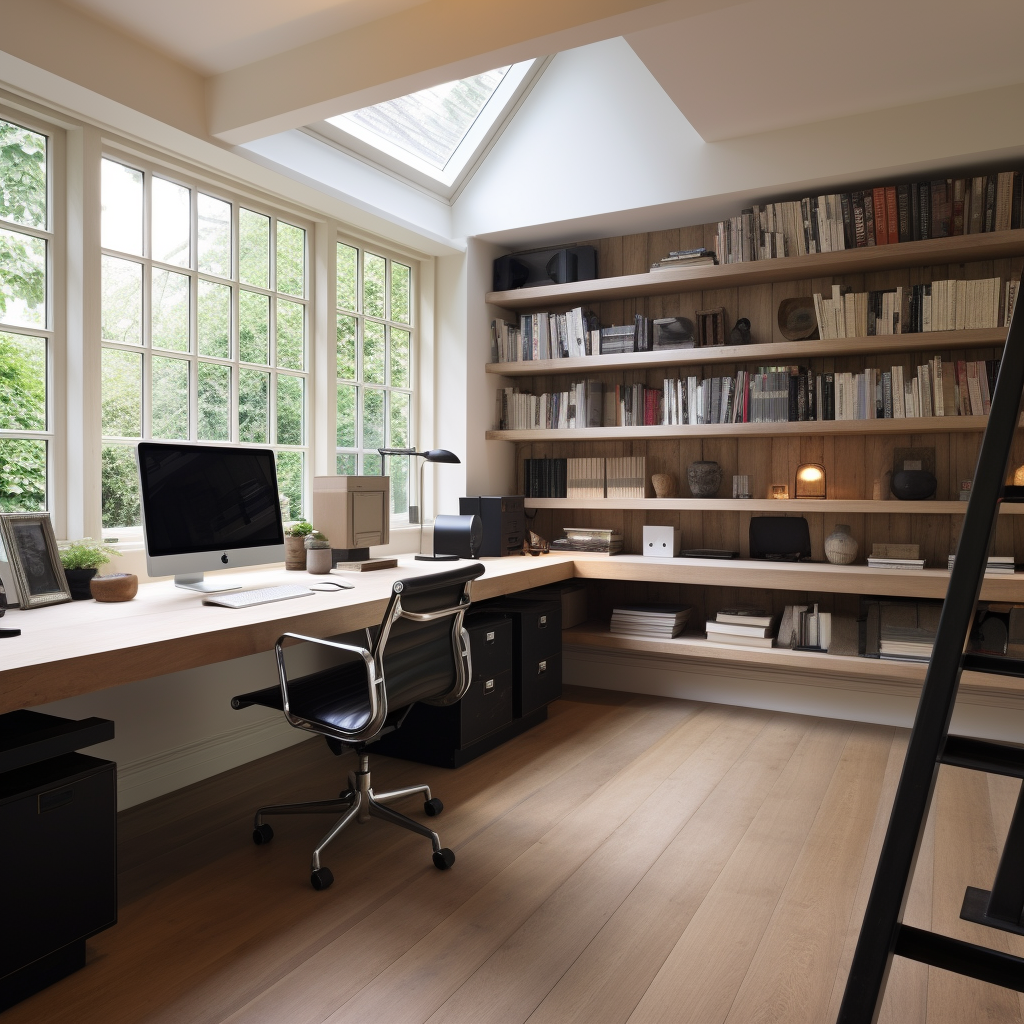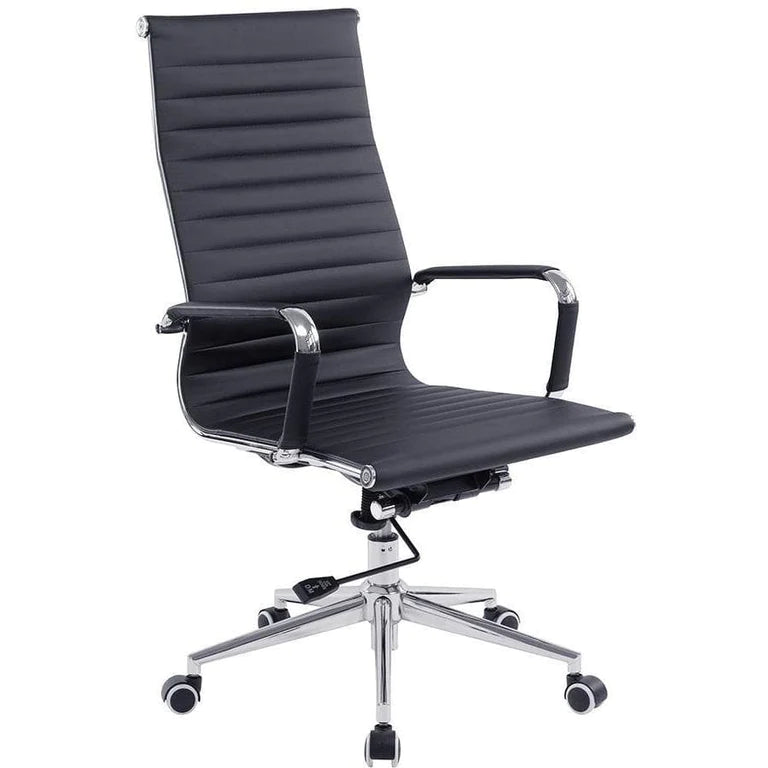
Office Design Trends: White Office Furniture

Introduction
In the vibrant world of interior design, trends ebb and flow with the rhythm of time and innovation. One wave that has persistently surged in recent years, carving a niche of its own in the professional setting, is the gravitation towards white office furniture. Renowned for its clean, sleek appeal and the profound sense of tranquility it imbues in the workplace, white office furniture is no longer just a design choice - it's a statement.
This design aesthetic has permeated the corporate world, from edgy startups to established enterprises, transcending industry boundaries. It is an eloquent expression of a company's commitment to simplicity, efficiency, and a pristine work culture. Through this comprehensive guide, we delve into the compelling world of white office furniture, exploring its evolution, benefits, popular styles, and much more.
As you read, consider your own office space. Does it inspire creativity, enhance focus, or simply make a statement about your brand? If your answer isn’t an unequivocal 'yes', then this exploration into white office furniture could offer you fresh, transformative perspectives. After all, the right environment can powerfully shape productivity and morale, and the choice of office furniture plays a pivotal role in creating such an environment. So, buckle up and join us on this journey as we delve into the transformative world of white office furniture.

The History and Evolution of White Office Furniture
To truly appreciate the allure of white office furniture, we must take a step back into the annals of design history. In the late 19th and early 20th centuries, office spaces were typically marked by hefty, dark-toned wooden desks and bookshelves. White was hardly a prominent feature in office spaces. In fact, it was often associated with sterile, uninspiring environments, far removed from the vigor of bustling business hubs.
The tides began to shift in the mid-20th century, influenced by the minimalist design movement and modernist trends that began to ripple through Europe. Architects and interior designers like Le Corbusier and Ludwig Mies van der Rohe pioneered the use of white in modern designs, in their quest to imbue simplicity and functionality into spaces. Gradually, white was seen as a symbol of efficiency, purity, and modernity. This philosophy soon transcended into office design.
The real turning point came with the digital revolution of the late 20th century. As companies pivoted towards more technology-oriented operations, office spaces underwent a significant transformation. The archaic wooden furniture made way for sleek, streamlined designs aimed at maximizing efficiency and space utilization. In this shifting landscape, white emerged as a preferred color choice for office furniture. It represented a break from the past and mirrored the new age of innovation and forward-thinking.

Today, white office furniture has evolved beyond a trend - it has become a manifestation of a modern, progressive work culture. The advent of open floor plans, coworking spaces, and the need for flexible office arrangements have cemented the position of white office furniture in contemporary design. Its versatility, ability to create an illusion of larger space, and its knack for fostering a bright, conducive work environment are characteristics that make it an enduring choice among businesses, big and small.
As we navigate through the era of remote work and hybrid offices, white office furniture continues to adapt and thrive. It resonates with the modern-day ethos of minimalism and functionality, all the while adding an aesthetic charm to the workspace. In the sections that follow, we will delve deeper into the reasons behind this appeal, the design trends of 2023, and how you can incorporate white office furniture into your office, no matter its size or style.
Why White Office Furniture? The Appeal and Benefits
White office furniture – the mere mention of it evokes images of minimalist, sleek, and light-filled spaces. However, beyond its undeniable aesthetic appeal, white office furniture offers an array of compelling advantages. It exudes a particular charm and brings numerous benefits to any workspace, from enhancing productivity to infusing an aura of professionalism. Let's dive into why white office furniture is more than just a trend.
Boosting Space Perception
White has a magical property – it can make any room look larger and brighter. White office furniture, therefore, plays a significant role in enhancing the perception of space. Especially in compact office settings, white desks, chairs, or storage units can make the space appear less cluttered and more spacious. This is crucial for promoting a sense of calmness and focus, enabling employees to perform their tasks without feeling cramped.

Encouraging Creativity
White is like a blank canvas. It symbolizes openness and infinite possibilities. As a neutral shade, it doesn't distract but rather encourages a free flow of ideas, making it a perfect color choice for spaces where creativity and innovation are pivotal – think brainstorming rooms, design studios, or advertising agencies.
Flexibility and Versatility
The color white is incredibly versatile. It seamlessly complements any other color and matches various interior styles, from ultra-modern minimalist offices to more traditional, rustic workplaces. This means as your office design evolves, white office furniture will continue to fit in, saving you from frequent and costly furniture updates.
Professional and Clean Aesthetic
White furniture adds a clean, professional aesthetic to any office space. It communicates a sense of organization, efficiency, and commitment to high standards. A well-maintained white office exudes an impression of meticulousness and attention to detail, subtly reflecting these values to both employees and visitors.
Enhances Lighting
White furniture has a unique ability to reflect natural light, thereby illuminating the office space. A well-lit office is not only more energy-efficient but also crucial for employee well-being. Adequate lighting reduces eye strain and fatigue, leading to increased productivity.

Psychological Comfort
White is often associated with purity, peace, and tranquility. In a high-stress work environment, white office furniture can subconsciously contribute to mental comfort and a sense of calm, helping to enhance employee well-being.
Case in Point: Apple Inc.
One of the most renowned examples of a global company harnessing the power of white office furniture is Apple Inc. The tech giant, known for its minimalist product design, extends the same philosophy to its workspaces. Apple’s offices worldwide are characterized by an extensive use of white - from sleek white desks and ergonomic chairs to minimalist storage units.
The idea behind Apple's choice of white office furniture lies in its commitment to simplicity, functionality, and innovation - values that are reflected in its product line. The consistent use of white in its office design helps reinforce its brand identity. Not just that, it creates a distraction-free environment where employees can focus and innovate, aligning perfectly with the company's ethos of fostering creativity and forward-thinking.

Apple's 'spaceship' campus, Apple Park, is a testament to this commitment. Its interior is a symphony of white, interspersed with massive glass doors and windows that invite natural light, further enhancing the brightness brought on by the white furniture. The result is a workspace that is not just aesthetically pleasing but also promotes an open, collaborative, and innovative work culture.
Apple's choice of white office furniture demonstrates how design can transcend aesthetics and functionality, becoming a manifestation of a company's vision and values. Their global success story underscores the impact of workspace design on fostering a productive, creative, and efficient work environment. It's a persuasive endorsement of the benefits of embracing white office furniture – a design choice that's clearly more than a fleeting trend.
Understanding the Impact of White Office Furniture on Employee Productivity
Office design has a profound impact on employee productivity, and choosing the right office furniture plays a pivotal role in this dynamic. White office furniture, in particular, can influence several factors that contribute to employee productivity. It merges the boundaries of aesthetics and functionality, creating an environment conducive to focus, creativity, and efficiency. Here's how:
Enhancing Concentration
White office furniture can significantly enhance concentration levels. The color white is associated with clarity, cleanliness, and simplicity. It is non-distracting and can help employees focus on tasks at hand. A white desk or workstation, devoid of visual clutter, can lead to a more organized workspace that promotes better focus and productivity.
Encouraging Creativity
As mentioned earlier, white is akin to a blank canvas. It is open, expansive, and encouraging of creative thinking. It facilitates a free flow of ideas, vital in workplaces that rely on innovation and creative problem-solving. White office furniture can indirectly stimulate creative thinking and brainstorming.

Promoting Calmness
The color white is often associated with peace, calmness, and tranquility. In fast-paced, high-stress work environments, white office furniture can provide a psychological sense of calm and relaxation. This serene environment can reduce stress levels, thereby increasing the well-being and productivity of employees.
Creating an Illusion of Space
As noted previously, white office furniture can make an office space appear larger and more open. An open, bright space can reduce feelings of claustrophobia and increase employee satisfaction. When employees are comfortable in their work environment, it has a positive impact on their productivity levels.

Reflecting Light
White office furniture is excellent at reflecting natural and artificial light. Good lighting in a workspace reduces eye strain and fatigue, making it easier for employees to concentrate and maintain their productivity throughout the day.
In conclusion, the impact of white office furniture on employee productivity is multifaceted, ranging from psychological benefits to practical advantages. By incorporating white office furniture into office design, businesses can foster a work environment that supports employee well-being, creativity, and ultimately, their productivity.
Tips on Decorating with White Office Furniture
White office furniture presents a world of opportunities when it comes to office decor. Its versatile, neutral nature makes it an excellent foundation for creating a space that reflects your business's personality and values. Here are some insightful tips to help you harness the full potential of decorating with white office furniture, once you choose the furniture:
Play with Textures
While a monochromatic palette of white can look elegant and clean, it may also feel sterile if not done correctly. To add depth and interest to your workspace, incorporate a variety of textures. Use rugs, throws, or cushions in meeting areas, or consider textured wall hangings or curtains. Textured finishes for white furniture, like brushed metal or carved wood, can also add visual interest.
Use Color Accents
White office furniture provides a perfect backdrop for any color scheme. Add pops of color through accents like office stationery, wall art, plant pots, or even upholstered chairs. These will stand out against the white furniture and can be easily changed according to mood, season, or brand colors.

Incorporate Plants
Plants can breathe life into a white-themed office, adding a touch of nature and a refreshing green contrast. Plus, indoor plants are known to improve air quality and reduce stress, enhancing employee productivity and well-being.
Use Lighting Creatively
Lighting plays a key role in a white-themed decor. Besides the standard overhead lighting, consider using task lamps, floor lamps, or even string lights to create a warm and inviting atmosphere. Reflective surfaces, mirrors, or metallic accents can further enhance the lighting in your office.
Blend Different Styles
The neutral color of white office furniture allows you to blend different decor styles seamlessly. You can pair a modern white desk with a rustic wooden shelf or an industrial-style lamp, creating a unique and personalized office space.
Don’t Forget Comfort
While aesthetics are important, never compromise on comfort. Ensure your white office furniture is ergonomic, supporting good posture and comfortable work practices. Comfortable employees are happier and more productive.
Keep it Clean
One of the challenges of white furniture is that it shows dirt and grime more easily. Regular cleaning and maintenance should be a priority to keep your white office furniture looking fresh and inviting. Use protective covers where necessary and consider furniture materials that are stain-resistant and easy to clean.
By following these tips, you can create a stylish, efficient, and comfortable workspace that not only boosts employee morale and productivity but also leaves a lasting impression on every visitor. White office furniture, with its timeless appeal and versatility, can transform your office into a space that echoes your brand's ethos and ambition.
Maintaining White Office Furniture: Practical Tips
While white office furniture can significantly enhance the aesthetics and functionality of your workspace, it also calls for regular maintenance to keep it in prime condition. Here are some practical tips to help you maintain the crisp, clean look of your white office furniture:
Regular Cleaning
White office furniture requires regular cleaning to maintain its pristine appearance. Dust the furniture regularly to prevent build-up, and clean up any spills immediately to prevent staining. Use a soft, damp cloth for the best results. Avoid using harsh chemicals or abrasive cleaning tools that could damage the furniture's surface.
Use Protective Covers
To prevent stains and scratches, consider using protective covers on your white office furniture, especially on surfaces that see a lot of use, like desks. Glass tops can be an elegant and practical addition to white desks, protecting the surface while preserving the look.
Select Furniture with Easy-to-Clean Materials
When choosing white office furniture, opt for materials that are easy to clean and maintain. Laminate, metal, and leather are all good choices as they can typically be wiped clean easily. Some modern furniture also comes with special stain-resistant coatings.
Regular Maintenance
Ensure that your furniture is well-maintained. Tighten loose screws, oil hinges, and fix any damages as soon as you notice them. This not only helps maintain the furniture's appearance but also extends its lifespan.
Use Coasters and Desk Pads
Encourage employees to use coasters for hot or cold beverages and desk pads for writing to prevent rings and other marks from forming on the furniture surface.
Professional Cleaning
For stubborn stains, it may be worth investing in professional cleaning services. They have the tools and expertise to remove stains without damaging the furniture.
Sunlight Considerations
While natural light can make white furniture look stunning, prolonged direct exposure can cause yellowing over time. Use window treatments or position furniture in a way that minimizes direct exposure to sunlight.
Maintaining white office furniture might require a bit more effort compared to darker hues, but the result—a bright, clean, and inviting workspace—is well worth it. With these practical tips, your white office furniture can remain a vibrant part of your office environment for years to come.
Future Predictions: The Longevity of White Office Furniture Trend
White office furniture is not a newcomer in the world of interior design. Its appeal has spanned decades, defying transient trends to hold a constant spot in the hearts of designers and business owners alike. The question then arises - how long will this trend last? Is white office furniture a fleeting fad or a timeless classic? Let's explore.
White is a color (or absence of color) that is associated with concepts like purity, simplicity, and sophistication. Its versatility enables it to fit into any style of decor, from the ultra-modern minimalist to the rustic and traditional. These timeless associations and the adaptability of white make it a color that's unlikely to fall out of favor.
Moreover, with the evolving work culture and a growing emphasis on employee well-being and productivity, office environments are being designed to be more comfortable, serene, and akin to residential settings. White office furniture, with its ability to create a calm, spacious, and clean aesthetic, perfectly aligns with these evolving priorities.
The rise of remote work, spurred on by global events like the COVID-19 pandemic, has further cemented this trend. As home offices become more common, there's an increasing need for office furniture that blends with the residential decor, and white office furniture fits this bill perfectly.
Another trend influencing the future of white office furniture is the growing consciousness towards sustainability. The eco-friendly aspects of white office furniture, such as its ability to reduce lighting needs due to its reflective properties, contribute to its ongoing popularity.

Finally, the increasing recognition of the psychological impacts of workplace design on employee productivity, creativity, and overall job satisfaction ensures that design elements that enhance these aspects—like white office furniture—will continue to be popular.
In conclusion, the future of white office furniture seems bright. While trends come and go, the benefits of white office furniture are deeply rooted in psychology, sustainability, and aesthetics—factors that will continue to be relevant. As work culture continues to evolve, it's safe to predict that the demand for white office furniture will remain strong, making it a wise, long-term investment for any business.
References
- Knight, C., & Haslam, S. A. (2010). The Relative Merits of Lean, Enriched, and Empowered Offices: An Experimental Examination of the Impact of Workspace Management Strategies on Well-being and Productivity. Journal of Experimental Psychology: Applied, 16(2), 158–172. Link
- Kwallek, N., Lewis, C. M., & Robbins, A. S. (1988). Effects of Office Interior Color on Workers' Mood and Productivity. Perceptual and Motor Skills, 66(1), 123–128. Link
Berman, M. G., Jonides, J., & Kaplan, S. (2008). The Cognitive Benefits of Interacting with Nature. Psychological Science, 19(12), 1207–1212. Link - Read, M. A., Sugawara, A. I., & Brandt, J. A. (1999). Impact of Space and Color in the Physical Environment on Preschool Children's Cooperative Behavior. Environment and Behavior, 31(3), 413–428. Link
- Rashid, M., & Zimring, C. (2008). A Review of the Empirical Literature on the Relationships between Indoor Environment and Stress in Health Care and Office Settings: Problems and Prospects of Sharing Evidence. Environment and Behavior, 40(2), 151–190. Link
- Veitch, J. A. (2012). Work environments. In S. Clayton (Ed.), The Oxford handbook of environmental and conservation psychology (pp. 248–280). Oxford University Press. Link
- Veitch, J. A., Charles, K. E., Farley, K. M. J., & Newsham, G. R. (2007). A model of satisfaction with open-plan office conditions: COPE field findings. Journal of Environmental Psychology, 27(3), 177–189. Link
- Haynes, B. P. (2008). The impact of office layout on productivity. Journal of Facilities Management, Vol. 6 No. 3, pp. 189-201 Link
- Brennan, A., Chugh, J. S., & Kline, T. (2002). Traditional Versus Open Office Design A Longitudinal Field Study. Environment and Behavior, 34(3), 279–299. Link
- Küller, R., Ballal, S., Laike, T., Mikellides, B., & Tonello, G. (2006). The impact of light and colour on psychological mood: a cross-cultural study of indoor work environments. Ergonomics, 49(14), 1496–1507. Link










Great article! I never thought about white furniture as a centerpiece, but it makes sense. I’m definitely considering a white desk now for my home office.